OLDSMOBILE SILHOUETTE 1993 Owners Manual
Manufacturer: OLDSMOBILE, Model Year: 1993, Model line: SILHOUETTE, Model: OLDSMOBILE SILHOUETTE 1993Pages: 323, PDF Size: 17.13 MB
Page 181 of 323
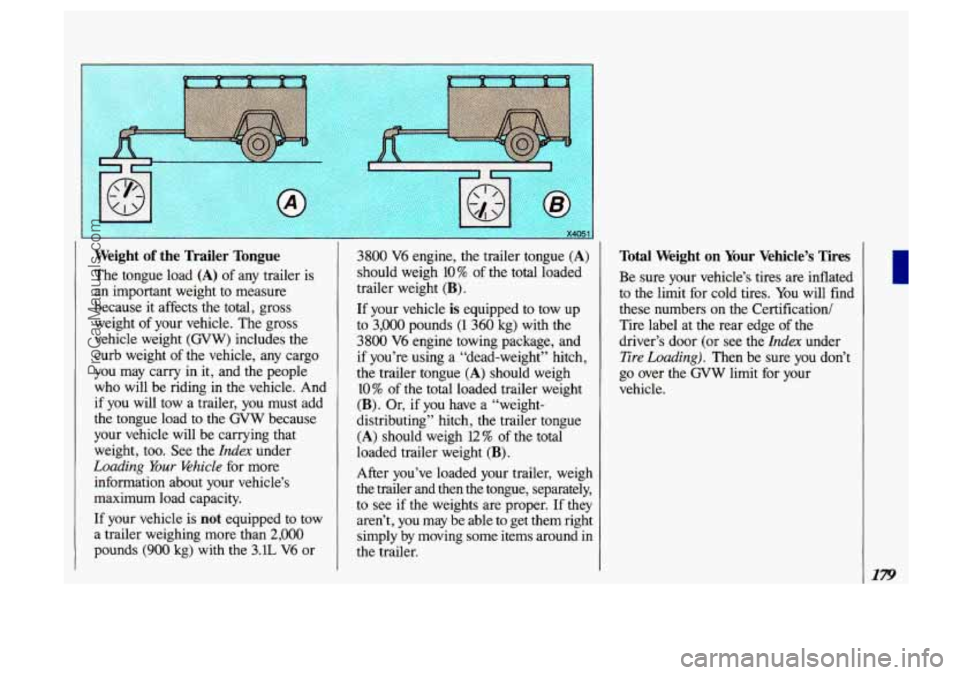
Weight of the Trailer Tongue
The tongue load (A) of any trailer is
an important weight to measure
because it affects the total, gross
weight of your vehicle. The gross
vehicle weight
(GVW) includes the
curb weight of the vehicle, any cargo
you may carry in it, and the people
who will be riding in the vehicle. And
if you will tow a trailer,
you must add
the tongue load
to the GVW because
your vehicle will be carrying that
weight, too.
See the Index under
Loading Your khicle for more
information about your vehicle’s
maximum load capacity.
If your vehicle is not equipped to tow
a trailer weighing more than
2,000
pounds (900 kg) with the 3.1L V6 or
3800 V6 engine, the trailer tongue (A)
should weigh 10% of the total loaded
trailer weight
(B).
If your vehicle is equipped to tow up
to
3,000 pounds (1 360 kg) with the
3800
V6 engine towing package, and
if you’re using a “dead-weight” hitch,
the trailer tongue
(A) should weigh
10% of the total loaded trailer weight
(B). Or, if you have a “weight-
distributing” hitch, the trailer tongue
(A) should weigh 12% of the total
loaded trailer weight
(B).
After you’ve loaded your trailer, weigh
the trailer and then the tongue, separately,
to see if the weights are proper. If they
aren’t, you may be able to get them right
simply by moving some items around in
the trailer.
Total Weight on Your Vehicle’s Tires I
Be sure your vehicle’s tires are inflated
to the limit for cold tires.
You will find
these numbers on the Certification/
Tire label at the rear edge
of the
driver’s door (or see the
Index under
Tire Loading). Then be sure you don’t
go over the GVW limit for your
vehicle.
ProCarManuals.com
Page 182 of 323
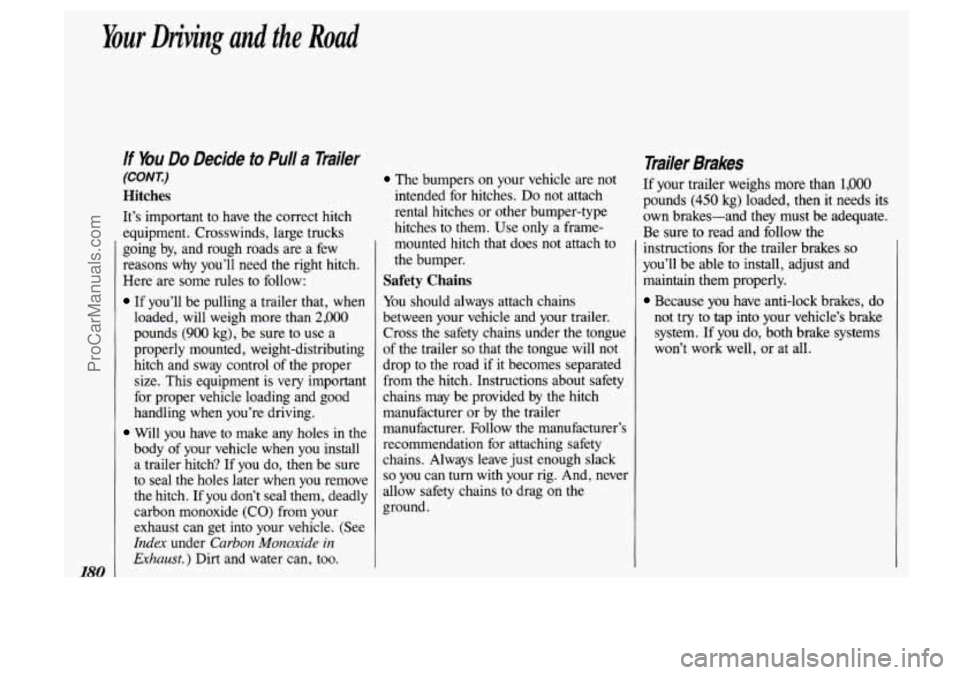
Your Driving and the Road
180
If You Do Decide to Pull a Trailer
(CON X)
Hitches
It’s important to have the correct hitch
equipment. Crosswinds, large trucks
going by, and rough roads are a few
reasons why you’ll need the right hitch.
Here are some rules to follow:
If you’ll be pulling a trailer that, when
loaded, will weigh more than 2,000
pounds (900 kg), be sure to use a
properly mounted, weight-distributing hitch and sway control of the proper
size. This equipment is very important
for proper vehicle loading and good
handling when you’re driving.
Will you have to make any holes in the
body of your vehicle when you install
a trailer hitch?
If you do, then be sure
to seal the holes later when you remove
the hitch. If
you don’t seal them, deadly
carbon monoxide (CO) from your
exhaust can get into your vehicle. (See
Index under Carbon Monoxide in
Exhaust.) Dirt and water can, too.
The bumpers on your vehicle are not
intended for hitches. Do not attach
rental hitches or other bumper-type
hitches to them. Use only a frame-
mounted hitch that does not attach to
the bumper.
Safety Chains
You should always attach chains
between your vehicle and your trailer. Cross the safety chains under the tongue
of the trailer
so that the tongue will not
drop to the road if it becomes separated
from
the hitch. Instructions about safety
chains may be provided by the hitch
manufacturer or by the trailer
manufacturer. Follow the manufacturer’s
recommendation for attaching safety
chains. Always leave just enough slack
so you can turn with your rig. And, never
allow safety chains to drag on the
ground.
Trailer Brakes
If your trailer weighs more than 1,OOO
pounds (450 kg) loaded, then it needs its
own brakes-and they must be adequate.
Be sure to read and follow the
instructions for the trailer brakes
so
you’ll be able to install, adjust and
maintain them properly.
Because you have anti-lock brakes, do
not try to
tap into your vehicle’s brake
system. If
you do, both brake systems
won’t work well, or at all.
ProCarManuals.com
Page 183 of 323
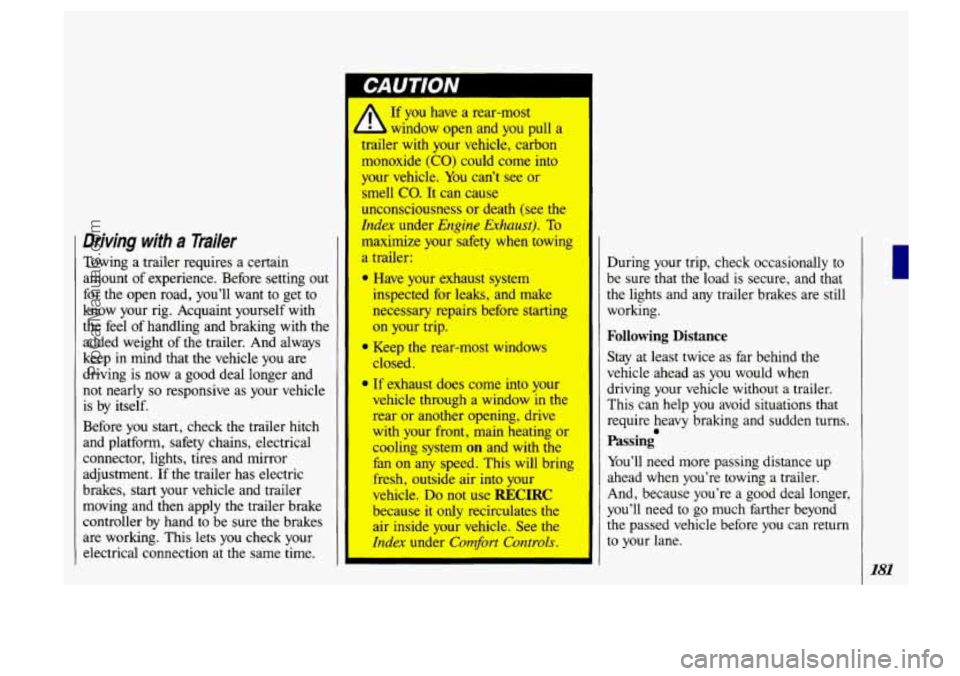
1 Driving with a Trailer
Towing a trailer requires a certain
amount of experience. Before setting out
for the open road, you’ll want to get
to
know your rig. Acquaint yourself with
the feel of handling and braking with the
added weight of the trailer. And always
keep in mind that the vehicle you are
driving is now a good deal longer and
not nearly
so responsive as your vehicle
is by itself.
Before you start, check the trailer hitch
and platform, safety chains, electrical
connector, lights, tires and mirror
adjustment.
If the trailer has electric
brakes,
start your vehicle and trailer
moving and then apply the trailer brake
controller by hand to be sure the brakes
are working. This lets you check your
electrical connection at the same time.
If you have a rear-most
window open and you pull a
mler with your‘vehicle, carbon
monoxide (CO) could come into
your vehicle. You can’t see or
smell CO. It can cause
unconsciousness or death (see the
Inh under Engine Exhausb). To I
maximize your safety when towing
a trailer:
@ Have your exhaust system
inspected for leaks, and Make
necessary yirs before starting
on your trip.
closed.
If exhaust does corne into your
vehicle through a window in the
fear or another opening, drive
with your front, main heating or
cmling system on and with the
fan on any speed. This WU bring
fresh, outside air into your
vehicle.
Do not use RECIRC
because it only recirculates the
air imide ywr vehick, See the
Index under Comfort &m&.
e KWP the =-most windows
During your trip, check occasionally to
be sure that the load is secure, and that
the lights and any trailer brakes are still
working.
Following Distance
Stay at least twice as far behind the
vehicle ahead as you would when
driving your vehicle without a trailer.
This can help you avoid situations that
require heavy braking and sudden turns.
Passing
You’ll need more passing distance up
ahead when you’re towing a trailer.
And, because you’re a good deal longer,
you’ll need to go much farther beyond
the passed vehicle before you can return
to your lane.
0
ProCarManuals.com
Page 184 of 323
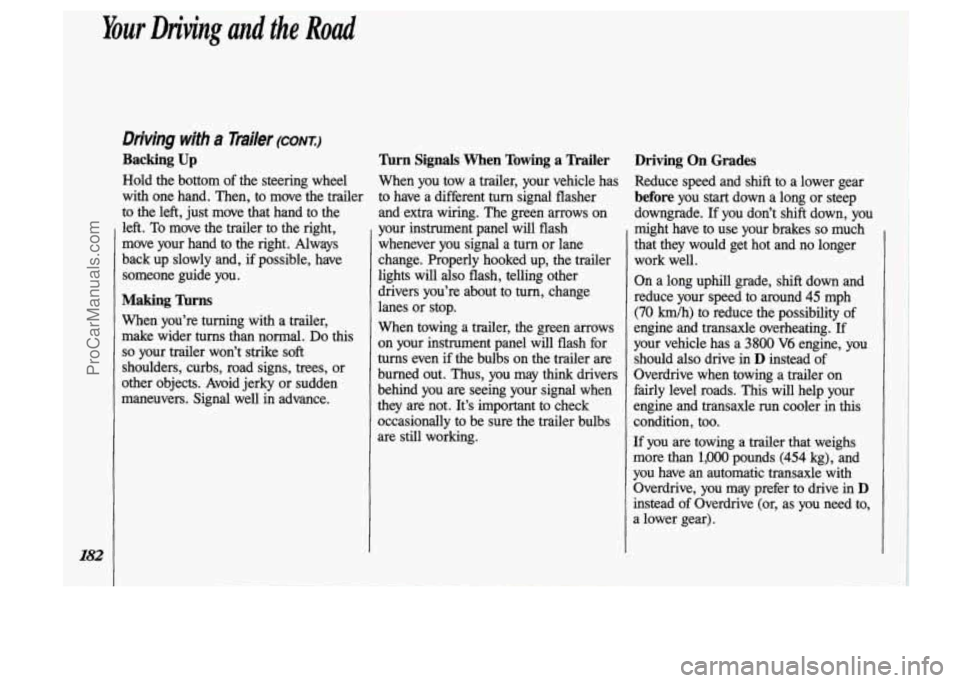
Your Driving and the Road
Driving with a Trailer (CONT.)
Backing Up
Hold the bottom of the steering wheel
with one hand. Then, to move the trailer
to the left, just move that hand
to the
left. To move the trailer to the right,
move your hand to the right. Always
back up slowly and, if possible, have
someone guide you.
Making Turns
When you’re turning with a trailer,
make wider
turns than normal. Do this
so your trailer won’t strike soft
shoulders, curbs, road signs, trees, or
other objects. Avoid jerky or sudden
maneuvers. Signal well in advance.
Turn Signals When Towing a Trailer
When you tow a trailer, your vehicle has
to have a different
turn signal flasher
and extra wiring. The green arrows on
your instrument panel will flash
whenever you signal
a turn or lane
change. Properly hooked up, the trailer
lights will also flash, telling other
drivers you’re about to
turn, change
lanes or stop.
When towing a trailer, the green arrows
on your instrument panel will flash for
turns even if the bulbs on the trailer are
burned out. Thus, you may think drivers
behind you are seeing your signal when
they are not. It’s important to check
occasionally to be sure the trailer bulbs
are still working.
Driving On Grades
Reduce speed and shift to a lower gear
before you start down a long or steep
downgrade.
If you don’t shift down, you
might have to use your brakes
so much
that they would get hot and no longer
work well.
On a long uphill grade,
shift down and
reduce your speed to around
45 mph
(70 Wh) to reduce the possibility of
engine and transaxle overheating. If
your vehicle has a 3800 V6 engine, you
should also drive in
D instead of
Overdrive when towing a trailer on
fairly level roads. This will help your
engine and transaxle run cooler in
this
condition, too.
If you are towing a trailer that weighs
more
than 1,000 pounds (454 kg), and
you have an automatic transaxle with Overdrive, you may prefer to drive in
D
instead of Overdrive (or, as you need to,
a lower gear).
ProCarManuals.com
Page 185 of 323
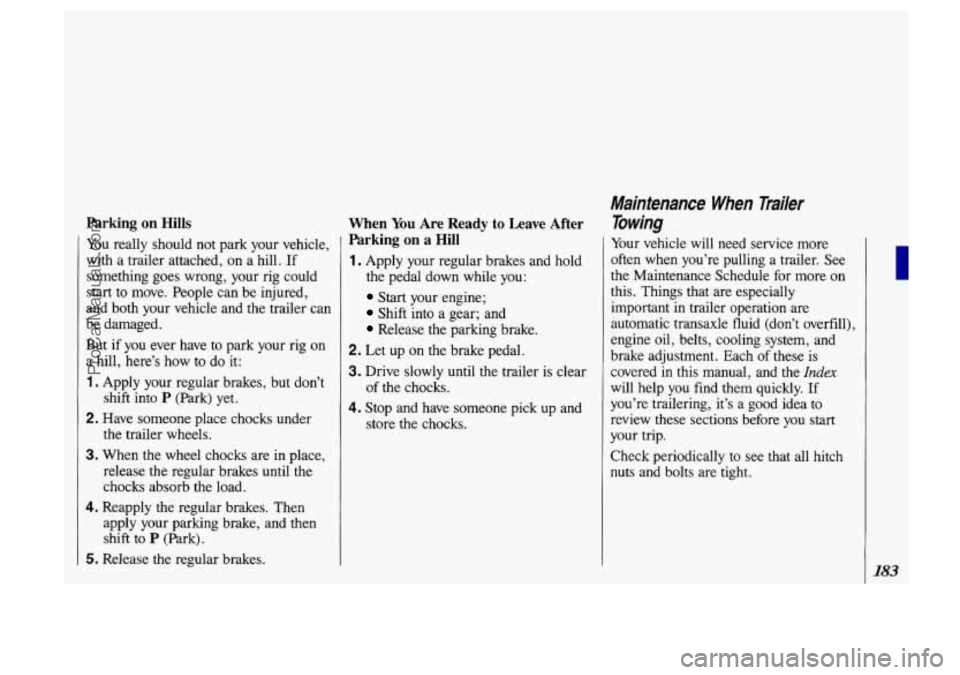
Parking on Hills
You really should not park your vehicle,
with a trailer attached, on a hill. If
something goes wrong, your rig could
start to move. People can be injured,
and both your vehicle and the trailer can
be damaged.
But if you ever have to park your rig on
a hill, here’s how to do it:
1 . Apply your regular brakes, but don’t
shift into
P (Park) yet.
2. Have someone place chocks under
the trailer wheels.
3. When the wheel chocks are in place,
release the regular brakes until the
chocks absorb the load.
apply your parking brake, and then shift to
P (Park).
4. Reapply the regular brakes. Then
5. Release the regular brakes.
When You Are Ready to Leave After
Parking on a Hill
1. Apply your regular brakes and hold
the pedal down while you:
Start your engine;
Shift into a gear; and
Release the parking brake.
2. Let up on the brake pedal.
3. Drive slowly until the trailer is clear
4. Stop and have someone pick up and
of the chocks.
store the chocks.
Maintenance When Trailer
Towing
Your vehicle will need service more
often when you’re pulling a trailer. See
the Maintenance Schedule for more on
this. Things that are especially
important in trailer operation are
automatic transaxle fluid (don’t overfill)
engine oil, belts, cooling system, and
brake adjustment. Each
of these is
covered in this manual, and the
Index
will help you find them quickly. If
you’re trailering, it’s a good idea to
review these sections before you
start
your trip.
Check periodically
to see that all hitch
nuts and bolts are tight.
183
ProCarManuals.com
Page 186 of 323
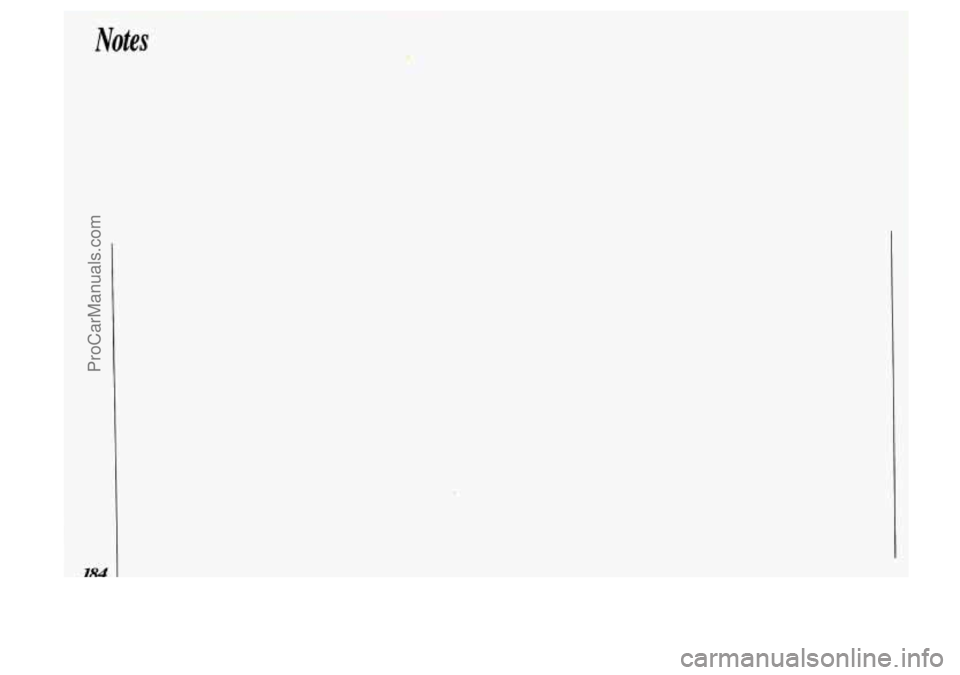
dotes
n
4'
ProCarManuals.com
Page 187 of 323
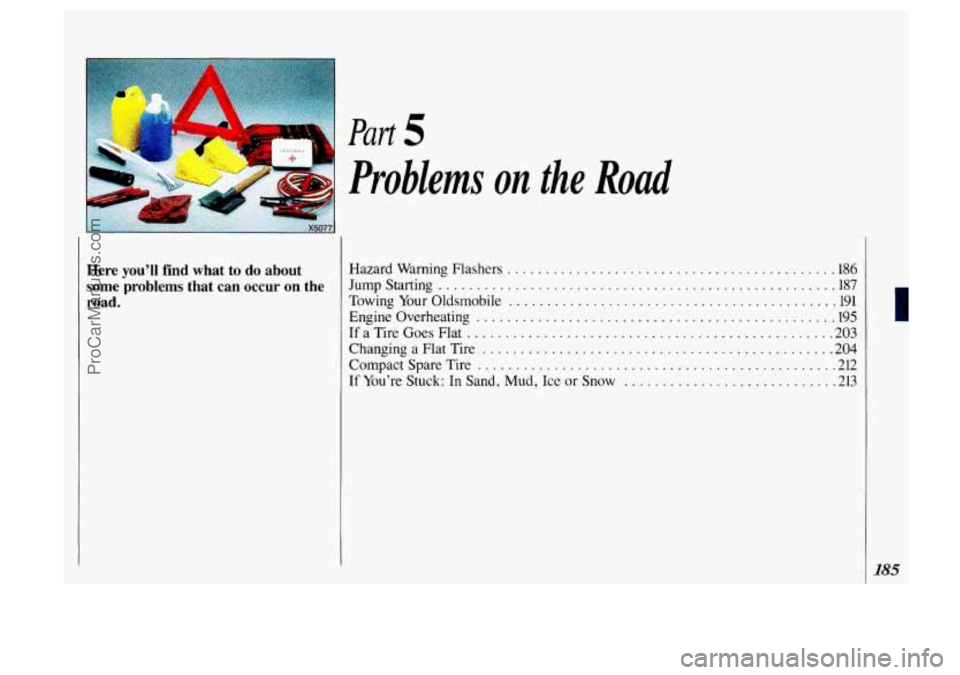
.....
Here you'll find what to do about
some problems that
can occur on the
road .
Part 5
Problems on the Road
Hazard Warning Flashers .... ............................... 186
Jumpstarting .................................................... 187
Towing Your Oldsmobile ........................................... 191
Engine Overheating ............................................... 195
If a Tire Goes Flat ................................................ 203
ChangingaFlatTire
.............................................. 204
Compact Spare Tire
............................................... 212
If You're Stuck: In Sand, Mud. Ice or Snow ............................ 213
ProCarManuals.com
Page 188 of 323
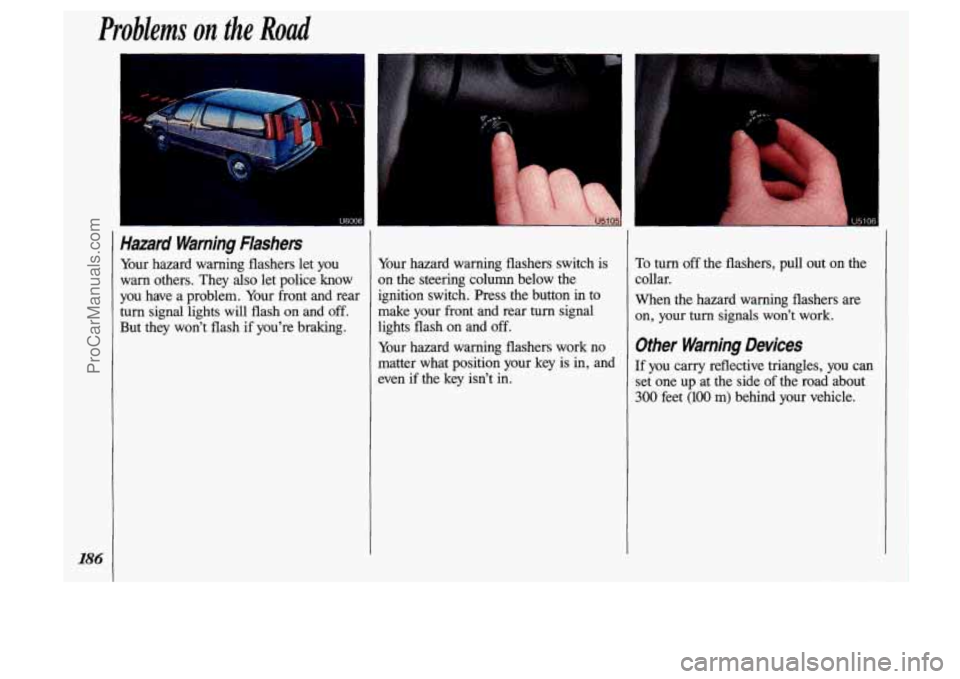
Problems on the Road
I
Hazard Warning Flashers
Your hazard warning flashers let you
warn others. They
also let police know
you have a problem. Your front and rear
turn signal lights will flash on and off.
But they won’t flash if you’re braking. Your
hazard warning flashers switch is
on the steering column below the
ignition switch. Press the button in to
make your front and rear turn signal
lights flash on and off.
Your hazard warning flashers work no
matter what position your key is in, and
even if the key isn’t in.
L
To turn off the flashers, pull out on the
collar.
When the hazard warning flashers are
on, your turn signals won’t work.
Other Warning Devices
If you carry reflective triangles, you can
set one up at the side of the road about
300 feet (100 m) behind your vehicle.
ProCarManuals.com
Page 189 of 323
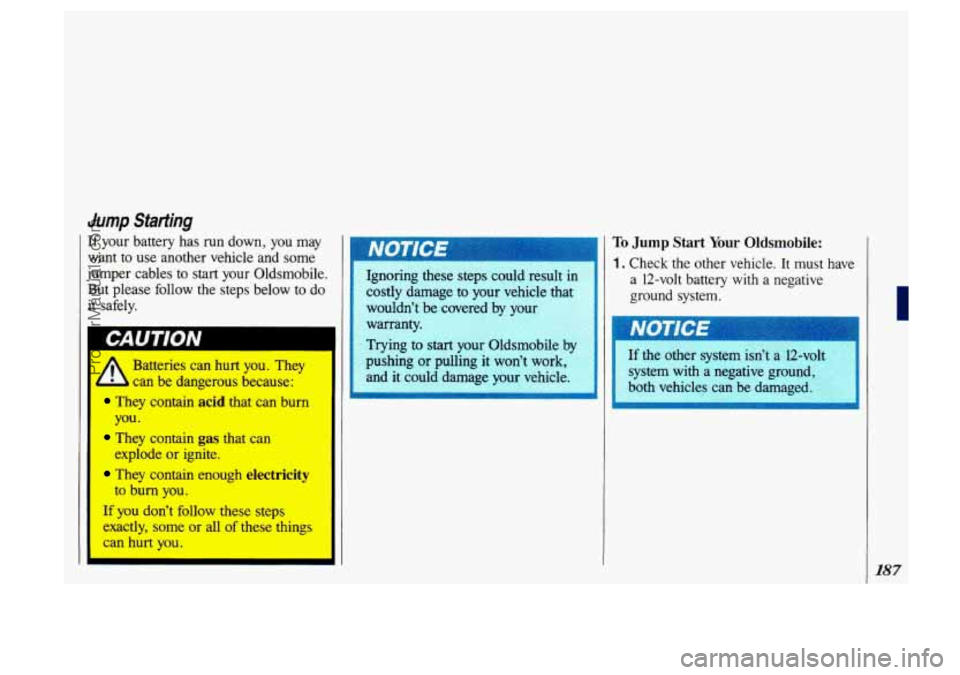
Jump Starting
If your battery has run down, you may
want to use another vehicle and some
jumper cables to start your Oldsmobile.
But please follow the steps below to do
it safely.
MU I IUIV
I; Batteries can hurt you. They
h can be dangerous because:
They contain acid that can burn
They contain gas that can
They contain enough electricity
If you don’t follow these steps
exactly, some or all
of these things
can hurt you.
you.
explode
or ignite.
to burn you. Ignoring
these steps could result in
costly damage to your vehicle that
wouidn’t becovered by your
warranty.
Trying to start your Oldsmobile
b
pushing or pulling it won’t work,
and it could damage your vehicle
To Jump Start Your Oldsmobile:
1. Check the other vehicle. It must have
a 12-volt battery with a negative
ground system.
ProCarManuals.com
Page 190 of 323
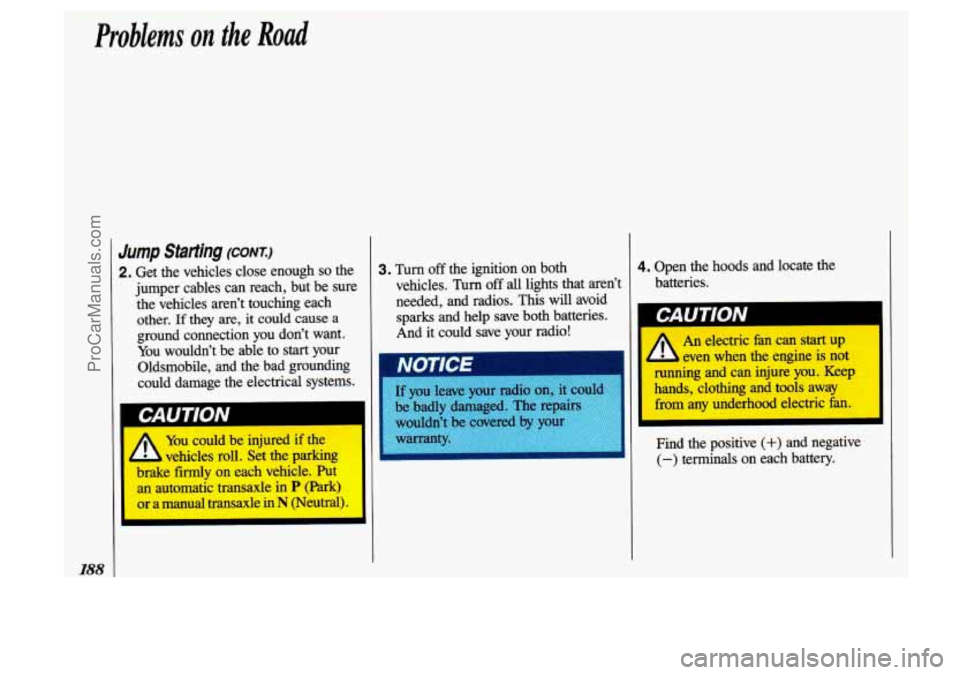
Problems on the Road
i
I
I
I
I88
Jump Starting (CONT.)
2. Get the vehicles close enough so the
jumper cables can reach, but be sure
the vehicles aren’t touching each other.
If they are, it could cause a
ground connection you don’t want.
You wouldn’t be able to start your
Oldsmobile, and the bad grounding
could damage the electrical systems.
You could be injured
if the
L vehicles roll. Set the parking
brake
firmly on each vehicle. Put
an automatic transaxle in
P (Park)
or a manual transaxle
in N (Neutral).
3. Turn off the ignition on both
vehicles.
Turn off all lights that aren’t
needed, and radios.
This will avoid
sparks and help save both batteries.
And it could save your radio!
4. Open the hoods and locate the
batteries.
r An electric fan can start up
even when the engine is not
I
I uming and can injure you. Keep
hands, clothing and tools away
from any underhood electric fan.
Find the positive
(+) and negative
(-) terminals on each battery.
ProCarManuals.com